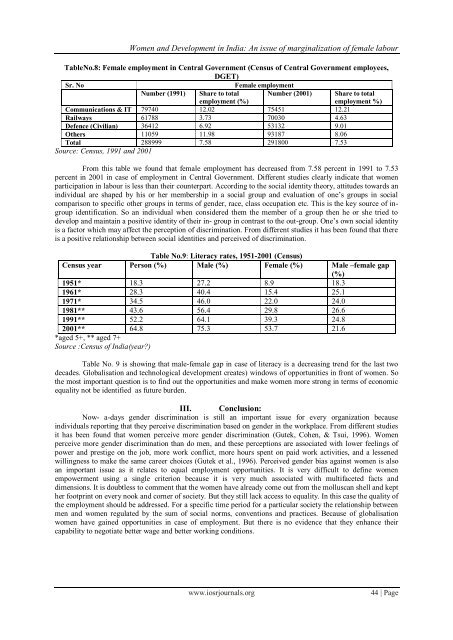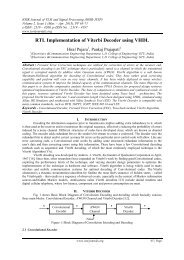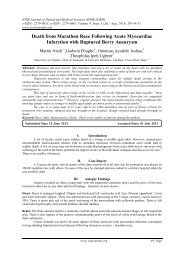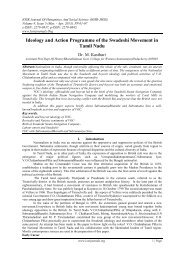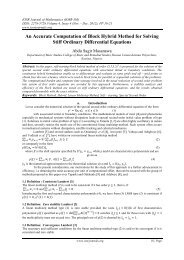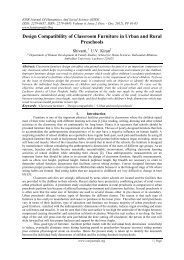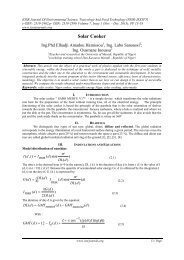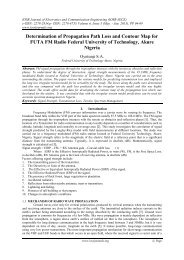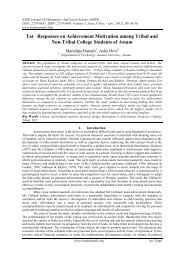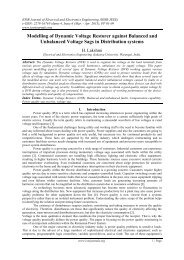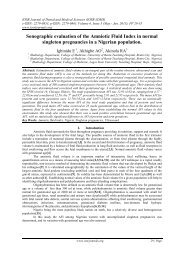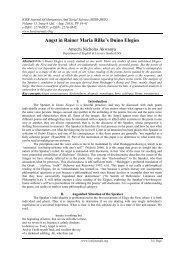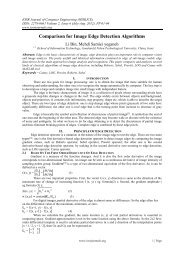Initial Conquest of India by Turks and Their Slaves - IOSR
Initial Conquest of India by Turks and Their Slaves - IOSR
Initial Conquest of India by Turks and Their Slaves - IOSR
Create successful ePaper yourself
Turn your PDF publications into a flip-book with our unique Google optimized e-Paper software.
Women <strong>and</strong> Development in <strong>India</strong>: An issue <strong>of</strong> marginalization <strong>of</strong> female labour<br />
TableNo.8: Female employment in Central Government (Census <strong>of</strong> Central Government employees,<br />
DGET)<br />
Sr. No<br />
Female employment<br />
Number (1991) Share to total<br />
employment (%)<br />
Number (2001) Share to total<br />
employment %)<br />
Communications & IT 79740 12.02 75451 12.21<br />
Railways 61788 3.73 70030 4.63<br />
Defence (Civilian) 36412 6.92 53132 9.01<br />
Others 11059 11.98 93187 8.06<br />
Total 288999 7.58 291800 7.53<br />
Source: Census, 1991 <strong>and</strong> 2001<br />
From this table we found that female employment has decreased from 7.58 percent in 1991 to 7.53<br />
percent in 2001 in case <strong>of</strong> employment in Central Government. Different studies clearly indicate that women<br />
participation in labour is less than their counterpart. According to the social identity theory, attitudes towards an<br />
individual are shaped <strong>by</strong> his or her membership in a social group <strong>and</strong> evaluation <strong>of</strong> one‟s groups in social<br />
comparison to specific other groups in terms <strong>of</strong> gender, race, class occupation etc. This is the key source <strong>of</strong> ingroup<br />
identification. So an individual when considered them the member <strong>of</strong> a group then he or she tried to<br />
develop <strong>and</strong> maintain a positive identity <strong>of</strong> their in- group in contrast to the out-group. One‟s own social identity<br />
is a factor which may affect the perception <strong>of</strong> discrimination. From different studies it has been found that there<br />
is a positive relationship between social identities <strong>and</strong> perceived <strong>of</strong> discrimination.<br />
Table No.9: Literacy rates, 1951-2001 (Census)<br />
Census year Person (%) Male (%) Female (%) Male –female gap<br />
(%)<br />
1951* 18.3 27.2 8.9 18.3<br />
1961* 28.3 40.4 15.4 25.1<br />
1971* 34.5 46.0 22.0 24.0<br />
1981** 43.6 56.4 29.8 26.6<br />
1991** 52.2 64.1 39.3 24.8<br />
2001** 64.8 75.3 53.7 21.6<br />
*aged 5+, ** aged 7+<br />
Source :Census <strong>of</strong> <strong>India</strong>(year?)<br />
Table No. 9 is showing that male-female gap in case <strong>of</strong> literacy is a decreasing trend for the last two<br />
decades. Globalisation <strong>and</strong> technological development creates) windows <strong>of</strong> opportunities in front <strong>of</strong> women. So<br />
the most important question is to find out the opportunities <strong>and</strong> make women more strong in terms <strong>of</strong> economic<br />
equality not be identified as future burden.<br />
III. Conclusion:<br />
Now- a-days gender discrimination is still an important issue for every organization because<br />
individuals reporting that they perceive discrimination based on gender in the workplace. From different studies<br />
it has been found that women perceive more gender discrimination (Gutek, Cohen, & Tsui, 1996). Women<br />
perceive more gender discrimination than do men, <strong>and</strong> these perceptions are associated with lower feelings <strong>of</strong><br />
power <strong>and</strong> prestige on the job, more work conflict, more hours spent on paid work activities, <strong>and</strong> a lessened<br />
willingness to make the same career choices (Gutek et al., 1996). Perceived gender bias against women is also<br />
an important issue as it relates to equal employment opportunities. It is very difficult to define women<br />
empowerment using a single criterion because it is very much associated with multifaceted facts <strong>and</strong><br />
dimensions. It is doubtless to comment that the women have already come out from the molluscan shell <strong>and</strong> kept<br />
her footprint on every nook <strong>and</strong> corner <strong>of</strong> society. But they still lack access to equality. In this case the quality <strong>of</strong><br />
the employment should be addressed. For a specific time period for a particular society the relationship between<br />
men <strong>and</strong> women regulated <strong>by</strong> the sum <strong>of</strong> social norms, conventions <strong>and</strong> practices. Because <strong>of</strong> globalisation<br />
women have gained opportunities in case <strong>of</strong> employment. But there is no evidence that they enhance their<br />
capability to negotiate better wage <strong>and</strong> better working conditions.<br />
www.iosrjournals.org<br />
44 | Page


